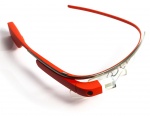Difference between revisions of "Main Page"
m (set new link to wiki structure list) |
m (corrected the semantic link in the featured article) |
||
| Line 13: | Line 13: | ||
! style="font-size: 140%; text-align: left; padding-left: 0.3em;" | <i class="fa fa-star fa-1x"></i> Featured - Google Glass | ! style="font-size: 140%; text-align: left; padding-left: 0.3em;" | <i class="fa fa-star fa-1x"></i> Featured - Google Glass | ||
|- | |- | ||
| − | | style="padding: 5px;" | [[File:GoogleGlass_4.jpg|150px|left|alt=Google Glass unit.|Google Glass.]] Google Glass are AR [[Is categorized as::smartglasses]] developed by [[Developed by::Google]] Inc. It is a standalone device that needs to be connected to other devices running Google’s [[ | + | | style="padding: 5px;" | [[File:GoogleGlass_4.jpg|150px|left|alt=Google Glass unit.|Google Glass.]] Google Glass are AR [[Is categorized as::smartglasses]] developed by [[Developed by::Google]] Inc. It is a standalone device that needs to be connected to other devices running Google’s [[Operating system is::Android]] OS, mainly smartphones. It uses a small display hovering in front of the user’s left or right eye. The user can control the device either by a small touch-pad on the side of the device or by using voice commands. The label glasses here could be misleading, by default Glass does not come paired with any lenses, the device itself is a slim glasses-like frame with the HUD unit attached to it. So far only a group of early-adopters selected by Google called ‘Glass Explorers’ could test out the device after paying 1500 USD for the developer version of it. After this testing phase, Google halted the sales of Glass, saying that it will take some time to perfect it. Thanks to a big marketing campaign, Google Glass created a number of controversies... ([[Google Glass|Full article]]) |
|- | |- | ||
| style="text-align: right; font-size: 90%;" | More about [[Smartglasses|smart glasses]]. | | style="text-align: right; font-size: 90%;" | More about [[Smartglasses|smart glasses]]. | ||
Revision as of 13:29, 31 August 2015
| Welcome to the HCE Wiki! | 443 pages, 2,805 edits, 233 files, 14 users | |
|---|---|---|
| The Human Cognitive Enhancement wiki, or HCE wiki in short, serves as an encyclopaedia of technologies that enhance or otherwise modify human cognition. It is not a mere database, though. We aim to provide not only a comprehensive list of available technologies but also a commentary on related topics such as health issues, controversies, socioeconomic implications and more. We also strive to approach each subject with care, research it properly and, if they are available, reference relevant sources, past research, and literature. The overall structure of this knowledge base, can be viewed here. The Human Cognitive Enhancement Wiki is a part of the HCENAT project. | ||
| Featured - Google Glass |
|---|
| Google Glass are AR smartglasses developed by Google Inc. It is a standalone device that needs to be connected to other devices running Google’s Android OS, mainly smartphones. It uses a small display hovering in front of the user’s left or right eye. The user can control the device either by a small touch-pad on the side of the device or by using voice commands. The label glasses here could be misleading, by default Glass does not come paired with any lenses, the device itself is a slim glasses-like frame with the HUD unit attached to it. So far only a group of early-adopters selected by Google called ‘Glass Explorers’ could test out the device after paying 1500 USD for the developer version of it. After this testing phase, Google halted the sales of Glass, saying that it will take some time to perfect it. Thanks to a big marketing campaign, Google Glass created a number of controversies... (Full article) |
| More about smart glasses. |
| Wiki structure |
|---|
| This knowledge base is built upon the following taxonomy of HCE technologies which we based upon the taxonomy Bostrom and Sandberg (2006) use in their work.
We start in the middle from the External Hardware or Software category and work our way through the structure bottom-up. In other words, we will first describe the individual technologies and then comment on the entire meta-category after we feel that we sufficiently described its individual entries. You can learn about why we have chosen to create the structure like this on the Wiki Structure meta page.
|
| How to contribute? |
|---|
| If you are interested in contributing to this knowledge base, please follow the link in the top right corner and register your account to begin. In case you are completely new to wiki editing, see this guide to learn the basics. We also follow certain guidelines, you can find them on this page. For help on SemanticWiki categories, see the Semantic wiki formatting. |
| About HCENAT |
|---|
| Naturalness in Human Cognitive Enhancement project aims at building up a new international research partnership in the field of Human Cognitive Enhancement (HCE) and to provide clear and accessible HCE-related analysis, guidelines and directions for policymakers, stakeholders, HCE engineers and consumers. Its goal is to create a philosophically grounded, open and transparent framework for description, assessment and forecast of acceptability of HCE systems in public space and by society, as well as for HCE governance issues. The project will be finished in April 2017.
Within this project, we tightly cooperate with Charles University in Prague, 1st Faculty of Medicine, Prague Psychiatric Center, The Department of Cybernetics at University of West Bohemia and two Norwegian partners: University College of Gjøvik, Faculty of Health, Care and Nursing and Oslo and Akershus University College of Applied Sciences, Work Research Institute. |



